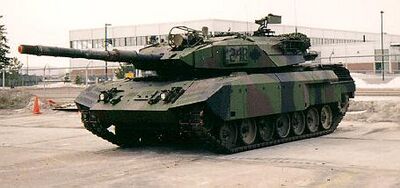Strv 104: Difference between revisions
No edit summary |
No edit summary |
||
| Line 21: | Line 21: | ||
<!-- Production history --> | <!-- Production history --> | ||
| designer = Landrut Landsystemet GmbH <br> Landsverk AG <br> Maybach AG <br> Kobalt-Zeiss GmbH & Co KG <br> Thyssen AB | | designer = Landrut Landsystemet GmbH <br> Landsverk AG <br> Maybach AG <br> Kobalt-Zeiss GmbH & Co KG <br> Thyssen AB | ||
| design_date = | | design_date = 1955-1961 | ||
| manufacturer = Landrut Landsystemet GmbH | | manufacturer = Landrut Landsystemet GmbH | ||
| unit_cost = | | unit_cost = | ||
Revision as of 21:00, 6 August 2021
| Stridsvagn 104 Lynx | |
|---|---|
 Acrean Strv 104A5 | |
| Type | Main Battle Tank |
| Place of origin | |
| Service history | |
| In service | 1965-Present |
| Used by | |
| Production history | |
| Designer | Landrut Landsystemet GmbH Landsverk AG Maybach AG Kobalt-Zeiss GmbH & Co KG Thyssen AB |
| Designed | 1955-1961 |
| Manufacturer | Landrut Landsystemet GmbH |
| Produced | 1965-Present |
| No. built | approx. 15,000 |
| Specifications | |
| Weight | 44 tonnes |
| Crew | 4 |
| Armor | Composite |
Main armament | KvK m/55 105mm smoothbore tank gun |
Secondary armament | Coaxial 7.62mm MG 59 Various Top-Mounted 7.62mm and 13mm guns |
| Engine | Thyssen-Maybach MTU K0-60 V12 Turbocharged Diesel |
Operational range | 500 km |
| Speed | 75 km/h (Road) ~50 km/h (Cross-Country) |
The Stridsvagn 104 Lynx is a main battle tank developed by Landrut Landsystemet in the 1960s for the Acrean Armed Forces.
History
Development
The development of Strv 104 can be fully traced back to the deployment of Strv 92 in the final years of the Eracuran Great War. One of the first true successful main battle tanks, Strv 92 featured a more powerful engine, main gun stabilisation, and more advanced infrared technology than its predecessors. Very well armed and well protected for its weight, the Strv 92 was by far the most effective of the new generation of vehicle designs introduced at the end of the war. Strv 91, derived from captured Azurlav vehicles and tested in limited numbers in late 1945, was considered unsatisfactory and frequently described as "cobbled together" by end users in the field and Armoured Corps testers alike. The Strv 73, while far more successful in its respective light tank role, was not considered suited for combatting the swathe of heavy tanks being deployed by Azurlav forces at the end of the war. Strv 92 would not enter service until mid-1946, and would only see a few months of combat before its end, but proved to be a substantial improvement in the capability of those armoured units equipped with them over earlier, older tanks.